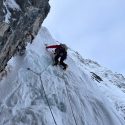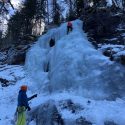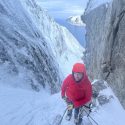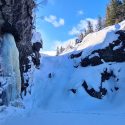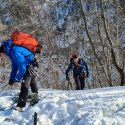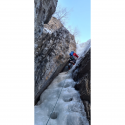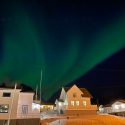Ex TIGER AMA ISKLATRING22 Expedition Report – Ulysses Trust ID 2833
In Feb – Mar 22 the Army Mountaineering Association (AMA) conducted an Adventure Training (AT) expedition to Norway to climb frozen waterfalls. The aim of the expedition was simple – push people outside their comfort zone, develop individual resilience, teamwork, and of course have a good time and learn some skills whilst doing it. The expedition had previously been run in 2019 and 2020, prior to a Covid enforced break in 2021. This time a decision was made to expand the scope of the expedition so that the instructors and leaders were challenged. This meant that we expanded to two phases. The first would see us deliver a foundation course or continuation training, with the second to challenge instructors.
Phase 1 – Rjukan
Rjukan is located in southern Norway, 76 miles west of Oslo. As an ice climbing venue it is outstanding. There are many routes from really easy, to really hard, the weather and ice is generally good, and the climbing is very accessible. You’d have to walk a few hours if you were trying to climb pure ice routes in the UK, but for Rjukan there are dozens less the 20mins from the carpark, with some starting at the side of the road. This means that you get much more time to focus on actual climbing, and less on walking.
For Phase 1 we had eight regular, and two reserve members of the AMA deploy. Despite some headaches with BA flight cancellations, we all made it out to take part in a demanding weeks climbing. With four instructors, two holding a foundation qualification, and four novices this phase had distinct aims. To deliver the Winter Climbing Foundation (WCF) qualification to the novices, and continue to develop those who already held WCF. The WCF course is a great course and teaches the foundation skills required to be safe to climb in winter conditions. The basic skills are the same as rock climbing, but there are significant additional factors to consider. One of the main being that you’re now doing all the skills in temperatures down to -20°C.
It all started fairly simple focussed on single pitch climbs, which are 20-30m long. Rjukan has several areas which are perfect for this, and you don’t get many single pitch winter climbing venues in Scotland. This means that people spend a considerable amount of time working on technique, without having spent 2hrs walking to get to the climbs. As the week progressed groups moved onto longer and steeper routes. The climbs we did varied from fairly relaxed 60° ice with a few bulges to get over, all the way up to 50m of 90° ice with no rests. This allows people to get comfortable on the lower grades, and then stretch them to expand their comfort zone, sometimes straying into panic. It’s why the Comfort Stretch Panic development model suits climbing.
By the end of the week everyone had pushed themselves, felt cold, panicked, and also had a good time. We had done routes of all grades, and all lengths. One team tackled the 800m long Gausta Marathon, and having been pleased to get the climb done spent 3½ hours wading through waist deep snow to travel the 2.5km back to the car. Snowshoes required next time!
Phase 2 – Senja
In a contrast to Phase 1 this phase saw members head up N to the island of Senja, within the Arctic Circle. Very little information was known about this area (there are no guidebooks), and the intent was to challenge the instructors and leaders. Unfortunately, only one instructor from Phase 1 could stay out, and he was joined by two other instructors who were unable to do Phase 1, both Reservists. With little information the hope was that instructors would be challenged. Instead of just picking up a guidebook and going climbing, they would have to research and recce climbing areas, navigate in, climb a route without knowing the grade, length, or the descent, then navigate back safely.
Unfortunately, the description of Senja as “Scotland on steroids” was fairly apt. Despite being there for a week there were quite a number of bad weather days, which meant that the team couldn’t get out climbing. However, the good weather days were not waisted, with some challenging climbs completed, leading into multiple abseil descents heading into the dark.
For a first expedition we were overly cautious, using it to develop leaders and instructors. However, they found that the island was a great location for hard winter climbing, and it would be possible to deliver a WCF. Therefore, one of the proposals from this expedition is to conduct a future expedition on Senja and deliver WCF up there.
Challenges
As with any AT expedition the challenge is getting overseas. There are numerous hurdles to jump through and as the AMA isn’t a unit it’s hard to overcome these issues. Whether it’s risk management, medical planning, finance, hire cars, equipment, it’s all hard for the AMA to deal with. Fortunately, on the finance side the funding provided by the Ulysses Trust meant that the reservists that deployed didn’t have to pay a personal contribution.
Benefits
In times of financial pressure on units, you could argue why do we do AT. The answer is simple. It’s a cost effective way to deliver demanding training to individuals. The cost per person from doing overseas AT is significantly lower, than a “green” exercise within the UK. The difference is when you conduct AT there is a real risk to life if someone doesn’t do their job properly. Operating in sub-zero temperatures each individual within the climbing team has to stay calm under pressure, ensure the safety of your team, work hard, exercise leadership, all whilst trusting that the 17cm aluminum ice screw weighing 100grams will hold in the ice and keep you safe.

